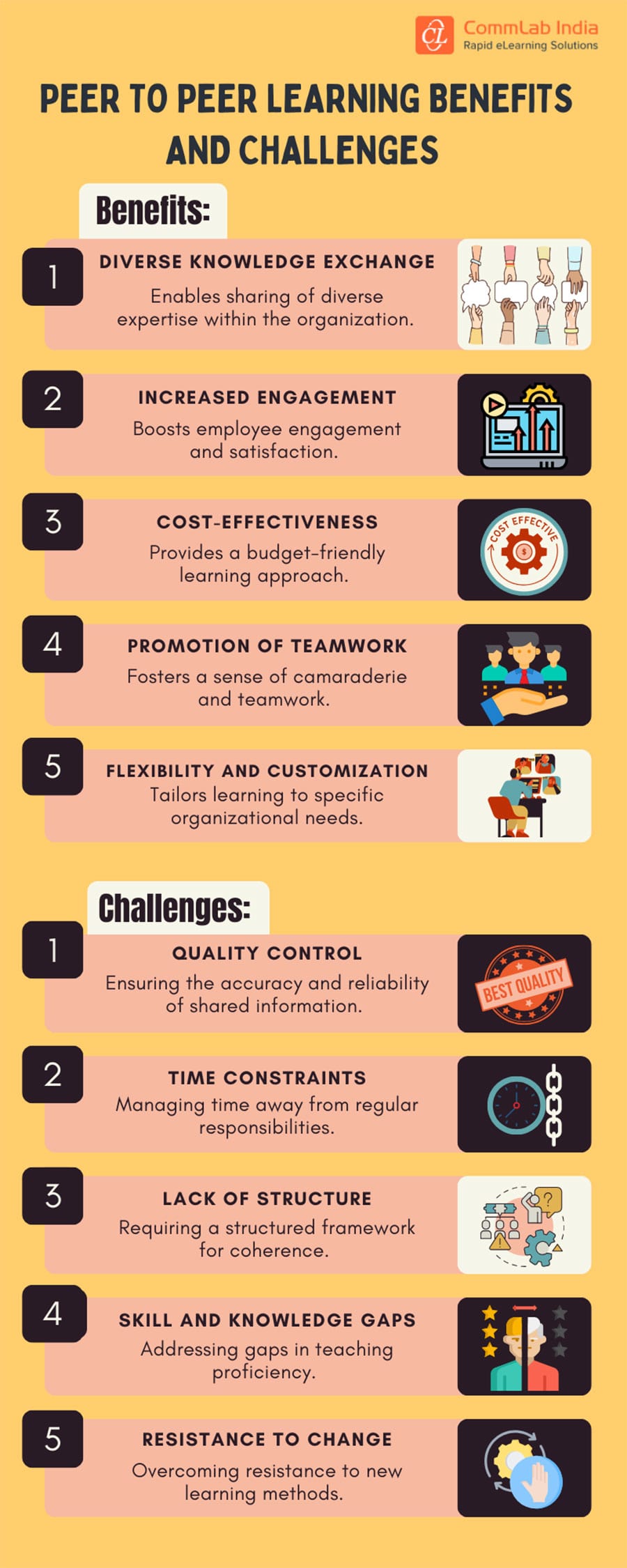Navigating Peer-to-Peer Learning: Methods, Perks and Challenges [Infographic]
![Navigating Peer-to-Peer Learning: Methods, Perks and Challenges [Infographic] Navigating Peer-to-Peer Learning: Methods, Perks and Challenges [Infographic]](https://blog.commlabindia.com/hubfs/blogs/peer-to-peer-learning-ways-infographic.jpg)
An HBR survey brings to light that more than 50% of employees seek out their peers for learning opportunities and problem-solving. Interesting, isn’t it? Learning from peers, who frequently double as friends, offers a sense of ease in the learning process, eliminating the fear of judgment, excessive questioning, and other uncomfortable scenarios.
Before delving into strategies for implementing peer-to-peer learning, take a glance at an infographic that outlines the remarkable advantages of peer-to-peer learning and the potential challenges in a corporate setting you should be mindful of.
Ways to Implement Peer-to-Peer Learning in Your Organization
Select a Peer Learning Facilitator
A peer learning facilitator is typically an individual who possesses not only a deep understanding of the subject matter but also the ability to guide and engage fellow learners effectively. They serve as the bridge between learners and knowledge, creating a dynamic and interactive atmosphere for learning. The peer learning facilitator should exhibit strong communication and interpersonal skills for leading discussions, addressing questions, and fostering collaboration among peers. Additionally, they should be approachable and encouraging, making sure that all learners feel comfortable and motivated to participate.
Introduce a Buddy System
The buddy system involves pairing individuals to work closely together, sharing their experiences, and knowledge, and providing mutual assistance. In this system, one person can act as a mentor or guide, offering insights, advice, and assistance to their buddy, who may be newer or less experienced. The buddy, in turn, can bring fresh perspectives and ideas, that not only accelerate the learning process but also promote a supportive and inclusive culture. The buddy system has been proven to be particularly effective in onboarding, skill development, and ensuring teamwork.
Invest in Collaborative Learning Softwares
Software platforms such as Learning Management Systems (LMS) and Learning Experience Platforms (LXPs) provide an online environment where learners can interact, share knowledge, and collaborate seamlessly. These tools empower individuals to connect with their peers, bridging geographical gaps and creating a global community of learners. Furthermore, collaborative learning software encourages peer-to-peer learning, where participants can become both learners and instructors, leading to a dynamic and multi-faceted learning experience.
→ Download Now: Why Do You Need an Extended Enterprise LMS [Infographic]
Organize Networking Events
Establishing networking events for peer-to-peer learning facilitates knowledge exchange, collaboration, and professional growth. These events provide a platform for individuals with similar interests, challenges, or career objectives to connect, interact, and learn from one another. Events like happy hour meetups, team lunches or industry allow employees to engage in meaningful discussions and tap into the collective wisdom of their peers.
Wrapping it Up!
Everyone at work requires assistance at some point, and nothing beats assistance from a peer. Therefore, peer-to-peer learning makes learning a breeze.
So, incorporating peer-to-peer learning into employee training can significantly boost learner engagement and leads to higher retention rates. As mentioned earlier, collaborative learning software is a valuable tool for nurturing peer-to-peer learning. To assist you in launching peer-to-peer learning within your organization and selecting the right Learning Management System (LMS), here’s a comprehensive eBook packed with insights on effective LMS implementation.




![Extended Enterprise LMS — How it Can Level Up Corporate Training [Infographic]](https://no-cache.hubspot.com/cta/default/59327/289182da-2644-4b4f-b232-31452836972b.png)


